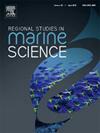通过整合光学活性物质优化沿海浑浊水域的卫星水深测量:来自SATCORE项目的见解
IF 2.1
4区 环境科学与生态学
Q3 ECOLOGY
引用次数: 0
摘要
卫星衍生测深(SDB)一直是研究的焦点,但其实际实施面临着持续的挑战,主要是由于悬浮物质,特别是在近岸地区。本研究旨在通过系统分析沿海水域光学活性物质(OAS)的空间分布,提高Landsat-7和Landsat-8光谱波段的SDB精度。本研究利用Lasso回归、弹性网和随机森林(RF)模型,探讨了印度国家海洋信息系统中心(INCOIS)发起的卫星海岸和海洋学研究(SATCORE)项目和测深法收集的生物地球化学水质变量之间的空间相互依存关系。该研究评估了各种特征在推导SDB中的预测能力和重要性。特征重要性分析表明,0.561 μm波段在所有数据集中起主导作用,而其他环境变量的影响程度各不相同。研究结果强调了先进的机器学习模型(特别是RF)在优化SDB映射方面的有效性,提高了具有高悬浮物水平的复杂沿海地区预测的准确性。本文章由计算机程序翻译,如有差异,请以英文原文为准。
Optimizing satellite-derived bathymetry in coastal turbid waters through integration with optically active substances: Insights from the SATCORE project
Satellite-Derived Bathymetry (SDB) has long been a focus of research, yet its practical implementation faces persistent challenges, primarily due to suspended materials, especially in nearshore regions. This research aims to enhance SDB accuracy using Landsat-7 and Landsat-8 spectral bands by systematically analyzing the spatial distribution of Optically Active Substances (OAS) in coastal waters. This study explores the spatial interdependencies among bio-geo-chemical water quality variables collected by Indian National Center for Ocean Information System (INCOIS) initiated SATellite Coastal and Oceanographic Research (SATCORE) project and bathymetry using Lasso Regression, Elastic Net, and Random Forest (RF) models. The study evaluates the predictive power and importance of various features in deriving SDB. Feature importance analysis showed that the spectral band 0.561 μm played a dominant role across all datasets, while other environmental variables had varying levels of influence. The results highlight the effectiveness of advanced machine learning models, particularly RF, in optimizing SDB mapping, enhancing the accuracy of predictions in complex coastal regions with high levels of suspended materials.
求助全文
通过发布文献求助,成功后即可免费获取论文全文。
去求助
来源期刊

Regional Studies in Marine Science
Agricultural and Biological Sciences-Ecology, Evolution, Behavior and Systematics
CiteScore
3.90
自引率
4.80%
发文量
336
审稿时长
69 days
期刊介绍:
REGIONAL STUDIES IN MARINE SCIENCE will publish scientifically sound papers on regional aspects of maritime and marine resources in estuaries, coastal zones, continental shelf, the seas and oceans.
 求助内容:
求助内容: 应助结果提醒方式:
应助结果提醒方式:


